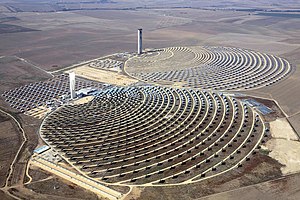 Image via Wikipedia
Image via Wikipedia
Malaysia, with population of about 28
million, is one of the fastest-growing economies in Asia. Although
blessed with petroleum resources, this strategically-important Southeast
Asian nation is relatively a small producer with reserves of 5.5
billion barrels of oil and 88 trillion cubic feet of natural gas.
Malaysia has significant natural gas exploration and development in the
Malaysia-Thailand Joint Development Area, located in the lower part of
the Gulf of Thailand, which is highlighted by almost three-fourth share
of natural gas in the energy mix in 2009.
During the last decade, Malaysia has seen
almost 20 percent increase in energy generating capacity from 13,000MW
in the year 2000 to 15,500MW in 2009. The maximum demand for
electricity last year was 14,000MW in Peninsular Malaysia, 700MW in
Sabah and 900MW in Sarawak. Electricity generation in Malaysia is
projected to grow further at an average annual rate of 4.7 percent. Most
of power stations in Malaysia are based on fossil fuels as the energy
mix is heavily dominated by natural gas and coal. Thermal power plants
contribute 86 percent while hydropower plants account for 13 percent to
the electricity generation capacity. Tenaga Nasional Berhad (TNB) is the
largest electricity utility company in the country with generation
capacity of 10,481MW. Other major utility companies are Sarawak
Electricity Supply Company (SESCO) and Sabah Electricity Limited (SESB).
Under the 8th Malaysia Plan (2001–2005), the government of Malaysia changed the Four-Fuel Policy (based on oil, gas, coal and hydropower) to the Five-Fuel Policy with the addition of renewable energy as the fifth source of fuel. |
The Ninth Malaysian Plan (2006-2010)
targets 350 MW of grid-connected renewable electricity by with fuel mix
of 40 percent gas, 40 percent coal, 10 percent hydropower and 10 percent
renewable energy. Another major development in the offing is the
proposed introduction of feed-in-tariff for renewable energy in 2011.
Renewable Energy Resource Potential in Malaysia (in MW)
Biomass 2400Biogas 410 Solar 6500 Municipal Waste 400 Mini-hydro 500 Total 10,210 |
Among the various sources of renewable
energy, biomass seems to be the most promising option for Malaysia. In
line with the promotion of using biomass energy, a Biomass Power
Generation & Cogeneration Project (BioGen) was commissioned in
October 2002. Photovoltaic (PV) systems are also another attractive
renewable energy source for Malaysia as climatic conditions are
favorable for the development of solar energy. However there is not much
development in the domestic PV market despite the fact that Malaysia is
currently the world’s fifth largest producer of PV modules. To
encourage the development of grid-connected PV systems, the Government
is providing financial incentives through the Malaysia Building
Integrated Photovoltaic (MBIPV) Project.
